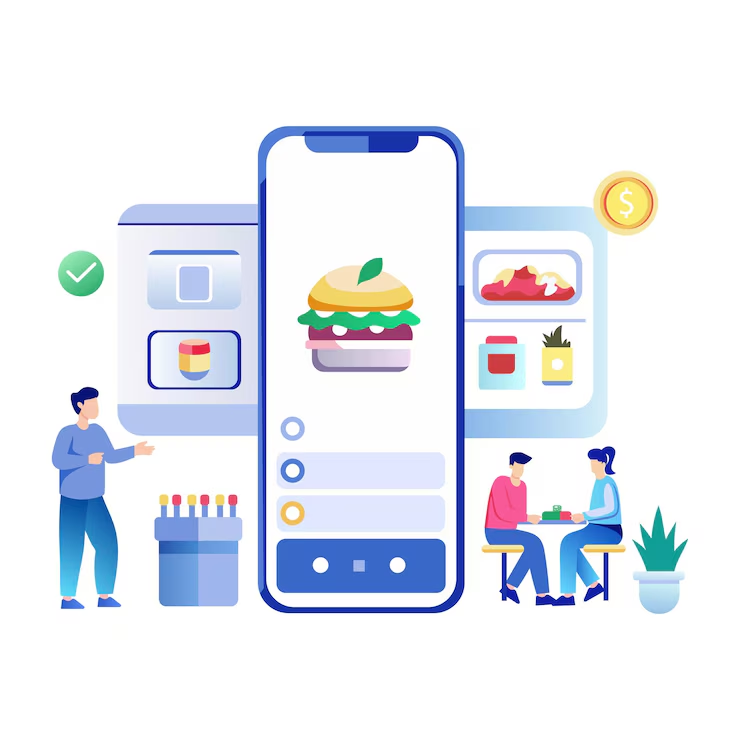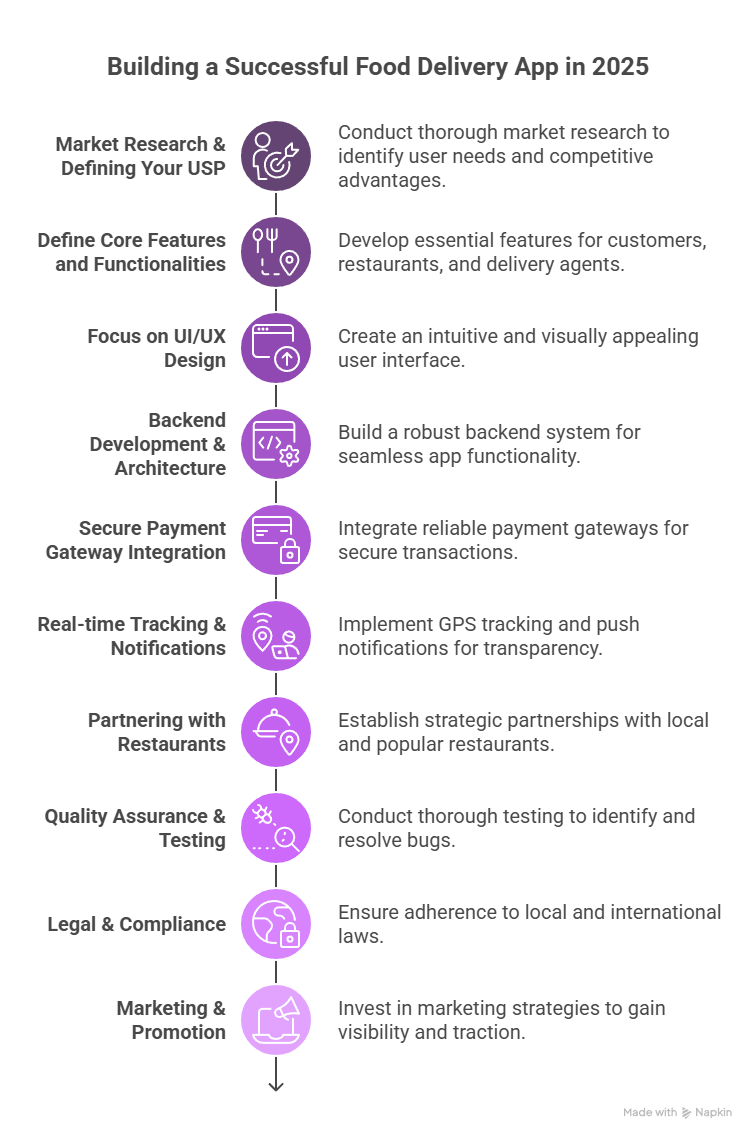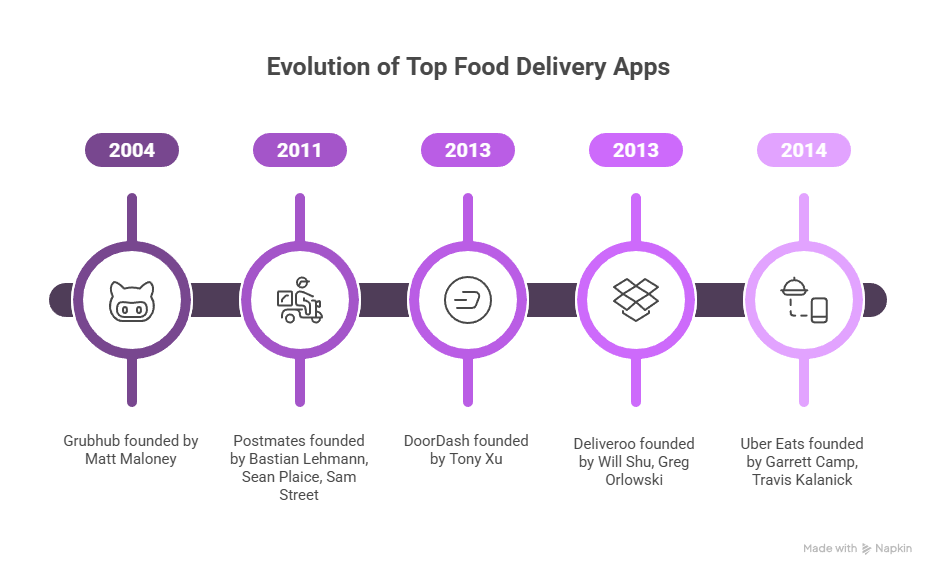
Creating a food delivery platform similar to Seamless opens the door for businesses to tap into a booming market and grow their customer base. An app like Seamless has carved a niche due to its smooth functionality and user-first design.
Table of Content
The widespread popularity of food delivery apps has inspired many entrepreneurs to invest in digital platforms that allow users to order meals effortlessly and have them delivered right to their doorsteps.
If you’re planning to build an app like Seamless, this comprehensive guide will walk you through the process, features, estimated costs, and other critical elements involved in developing a Seamless clone app.
Before we dive into the detailed development roadmap, let’s examine some industry statistics to better understand the opportunities in food ordering app development.
Seamless is a well-known food delivery and restaurant discovery platform that enables users to explore local eateries and place food orders online for doorstep delivery. It simplifies access to a wide range of cuisines from various restaurants, all within a single app.
If you aim to create a Seamless clone app, it’s essential to understand the features and functions that have contributed to its massive success. Here’s why the Seamless clone model is winning:

One of the primary reasons why users love Seamless is the vast selection of restaurants available on the platform. Users can browse numerous local dining options, place orders, and get meals delivered without switching between apps. This streamlined user experience is what makes a food-ordering app like Seamless so appealing.
When you develop a Seamless-like app, ensure it offers variety and easy access to different cuisines to mimic this success.
The app’s clean and intuitive design allows users to effortlessly browse menus, place customized orders, and track deliveries. From modifying ingredients to choosing portion sizes, the customization features add to its appeal.
When considering Seamless clone app development, focus on delivering an intuitive UI/UX that enhances convenience, one of the pillars of Seamless’s user satisfaction.
With just a few taps, users can place orders, making the app ideal for those who want quick and hassle-free meals. Enhanced with advanced search functionality and filters, the app allows users to find their favorite cuisine or dish in seconds.
Anyone looking to build a Seamless clone app should prioritize simplicity and speed to meet the expectations of modern consumers.
Another reason behind Seamless’s widespread success is its emphasis on on-time deliveries. Users appreciate receiving their meals within a reliable timeframe, and the app also provides real-time tracking to keep customers informed.
If you’re planning to build an app like Seamless, ensure real-time updates, ETA tracking, and in-app communication between drivers, users, and restaurants are part of your feature set.
Customization is a key feature that enhances user satisfaction. From dietary needs to ingredient substitutions, users love having control over how their meals are prepared. This includes options to add notes like “extra cheese” or “no gluten.”
A strong Seamless clone script should include advanced customization features to cater to a wide range of customer preferences.
Seamless engages users through attractive offers, promo codes, and discounts. Whether it’s free delivery, combo meals, or loyalty rewards, these perks keep customers coming back.
When you create a Seamless clone app, incorporate a robust promotional engine that supports limited-time deals, referral programs, and order-based discounts.
A Seamless clone app operates as an online food ordering and restaurant discovery platform, connecting users with various eateries to place orders for delivery or pickup. If you’re planning to develop a Seamless-like app, here’s a breakdown of how it typically functions:

Users begin by downloading a food ordering app like Seamless, registering for an account, and entering their delivery address. The app uses this information to suggest local restaurants and food options. For convenience, it can also detect the user’s current location using GPS.
This is a vital step in creating a Seamless clone app that ensures a personalized and location-specific user experience.
Once the address is confirmed, the app presents a list of restaurants in the vicinity. These listings are organized by cuisine, popularity, or specific food categories, allowing users to explore a variety of choices. When you build an app like Seamless, make sure to include filters that enhance discoverability.
Each restaurant profile in your Seamless clone script should include comprehensive details such as menu items, delivery charges, minimum order requirements, estimated delivery times, user ratings, and ongoing promotions. These help users make informed decisions before placing an order.
Users can browse the menu, select food items, and customize their orders according to personal preferences—adding instructions, selecting portion sizes, or modifying ingredients. These features are essential when you create a Seamless clone app that prioritizes user satisfaction.
The app should allow seamless and secure payment processing through credit/debit cards, wallets, or other digital gateways. This feature is critical to any Seamless clone app development project as it ensures smooth transactions and boosts trust.
After the payment, the order is transmitted to the restaurant through the app’s backend system. The restaurant then prepares the meal as per the user’s request. This backend flow is fundamental when you build a Seamless clone app.
One of the defining features of any app like Seamless is real-time tracking. Customers should be able to track the preparation, dispatch, and delivery progress through GPS. This transparency enhances user engagement and improves retention.
Upon receiving the order, users can rate their experience with both the restaurant and the delivery personnel. Ratings play a key role in improving services and also guide other users during their ordering decisions.
A reliable Seamless clone app should offer customer support via in-app chat or help center to resolve user issues promptly. This support system improves the overall user experience and builds brand credibility.
To ensure a competitive edge, you can integrate AI-based features that analyze user behavior and offer food suggestions based on past orders, dietary preferences, or time of day. This is particularly useful when you develop a food-ordering app like Seamless.
Before you develop an app like Seamless, it’s essential to understand the current food delivery market and its growth trajectory:
These numbers highlight the rising demand for food delivery apps, making this the ideal time to build an app like Seamless or invest in Seamless clone app development.
Food delivery apps such as Seamless are designed to make ordering food from local restaurants simple, efficient, and convenient. These platforms cater to three main user groups—Customers, Delivery Drivers, and Admins—each with tailored panels and features to streamline their experience.

The user panel is the front-facing interface of a food delivery app. It aims to enhance the customer’s overall experience through intuitive navigation and essential functionalities.

The driver panel is crucial for delivery personnel to manage logistics and ensure timely deliveries.
The admin panel controls the entire ecosystem, ensuring smooth operations, managing users, and analyzing performance.

Creating a food delivery app like Seamless requires more than just a good idea—it involves strategic planning, seamless execution, and a deep understanding of user needs. Whether you’re an entrepreneur or a tech startup looking to break into the food delivery industry, this comprehensive guide will walk you through every critical aspect of building a successful Seamless-like app.

Before you begin development, conduct thorough market research to understand your target audience, competitors, and industry trends. Ask key questions like:
Define a unique selling proposition (USP)—this could be hyper-local restaurant partnerships, zero delivery fees, sustainable packaging options, or AI-based dish recommendations.
The backbone of your app lies in its features. Your platform must cover three main user groups: customers, restaurants, and delivery agents. Here are the essential features for each:
Pro Tip: Add unique features like:
Your user interface must be intuitive and visually appealing across all mobile devices. Create detailed wireframes and prototypes before diving into full development.
A well-designed interface can significantly boost user engagement and retention.
Robust backend development ensures your app functions seamlessly behind the scenes. Choose a technology stack that aligns with scalability, performance, and developer availability.
Build your system with a modular architecture so that features can be updated without breaking the app.
Seamless transactions are a cornerstone of user trust. Integrate reliable payment gateways such as:
Ensure your payment system complies with PCI-DSS standards to protect financial data. Also, include multi-currency and wallet support if you plan to expand globally.
Users love transparency and speed. Integrate GPS tracking so users can monitor their delivery in real time.
Use push notifications for:
Each order should store transaction metadata like:
Establish strategic partnerships with a variety of restaurants—from local favorites to popular chains.
Ensure the admin panel allows restaurant partners to:
Before launching, conduct thorough testing to identify and resolve bugs.
Beta-test your app with real users to gain feedback and make necessary adjustments.
Your app must adhere to local and international laws regarding food delivery, payments, and data protection.
The admin panel should support the following:
Once your app is ready, invest in aggressive marketing to gain visibility and traction.
Offer restaurant partners co-marketing opportunities to expand your reach.
User feedback is gold. Integrate a feedback system within the app that allows users to report issues or share suggestions.
Use the data to:
Stay agile and continuously innovate based on user behavior analytics and market trends.
Seamless, now operating under the Grubhub brand, has long been a go-to food delivery and takeout app in the U.S. But if you’re exploring more food delivery platforms—either as a user or an entrepreneur looking to build your own app—understanding the competitive landscape is crucial.
Here’s a look at the top 5 apps like Seamless that dominate the food delivery market today. These apps offer great inspiration for developing your food delivery app or gaining a deeper insight into the food tech industry.
DoorDash is a food delivery powerhouse that connects local restaurants to consumers in over 800 cities across the U.S. With a focus on community-driven delivery and innovations like contactless delivery during the COVID-19 pandemic, DoorDash has firmly positioned itself as a leader.
Fun Fact: In 2019, DoorDash surpassed Uber Eats in market share and is now valued at over $16 billion.
Spun out from the Uber ride-sharing platform, Uber Eats delivers food in over 6,000 cities across 24+ countries. It offers a comprehensive menu view with descriptions, prices, and customer reviews, making ordering intuitive and personalized.
Uber Eats’ international presence and integration with the Uber app give it a strong competitive edge globally.
The original parent company of Seamless, Grubhub remains a top contender in the U.S. food delivery scene. With over 20 million active users and partnerships with 115,000+ restaurants, it’s a familiar and trusted choice for many Americans.
Grubhub also offers corporate accounts for businesses looking to streamline employee meals.
Acquired by Uber in 2020 for $2.65 billion, Postmates originally launched as an on-demand logistics company. It stands out for its reliable, timely deliveries and supports a wide range of local services beyond just food.
Postmates’ ability to deliver groceries, alcohol, and more makes it a versatile delivery platform.
Based in London, Deliveroo is a globally recognized food delivery app known for its efficient logistics and fee-based business model. It charges restaurants a commission and applies a per-order fee to customers, creating a robust revenue stream.
Though primarily based in the UK, Deliveroo operates in 10+ countries and continues to expand globally.

Creating a robust and scalable food delivery app requires the right blend of technology. Here’s a suggested tech stack to build a Seamless-like platform:

The food delivery app market is crowded but full of opportunity. If you’re aiming to build the next Seamless, you’ll need:
With continuous user feedback, iterative updates, and strategic marketing, you can craft a unique space in the competitive food delivery ecosystem.
At Code Brew Labs, we specialize in building custom food delivery apps tailored to your vision. As a leading app development company, we bring years of experience and a deep understanding of industry trends to the table. Our team creates platforms that not only rival industry giants like Seamless or Uber Eats — we help you innovate beyond them.
Why Choose Us?
Partner with Code Brew Labs to bring your food delivery idea to life. Let’s cook up something extraordinary together!
